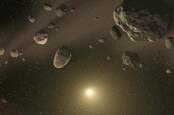This article is more than 1 year old
Lo and behold, Earth's special chemical cocktail for life seems to be pretty common
Maybe its inhabitants are mostly harmless and ordinary too
Earth appears to be unique and inhabited by living creatures, but the building blocks required for life to bloom are actually quite common, according to new research.
"Most of the building blocks we have looked at in other planetary systems have a composition broadly similar to that of the Earth", said Siyi Xu, an an assistant astronomer the at the Gemini Observatory in Hawaii. Xu is presenting the research at the Goldschmidt conference in Boston this week.
The prospects of finding life elsewhere in space get more promsing with better technology. The first confirmed discoveries of other exoplanets were made over a quarter of a century ago in 1992, and thousands of others have been found since.
Astronomers are particularly excited about planets that resemble Earth. These planets lie in the habitable zone around their parent star, so that their surface temperature is just right water to exist in liquid form. They should also have an atmosphere and the right mixture of chemicals such as oxygen, carbon and nitrogen.
These sorts of planets may be more common than previously thought, according to this study. The researchers measured the compositions of 18 different planetary systems up to 456 light years away, making it one of the largest surveys of its kind. Elements such as calcium, magnesium, silicon were detected around most of the white dwarf stars in the various planetary systems.
There were also promising signs of water in one of the systems. One of them in the constellation Boötes, about 170 light years away, appeared to be rich in carbon, nitrogen and water.
"White dwarfs' atmospheres are composed of either hydrogen or helium, which give out a pretty clear and clean spectroscopic signal. However, as the star cools, it begins to pull in material from the planets, asteroids, comets and so on which had been orbiting it, with some forming a dust disk, a little like the rings of Saturn.” Xu explained.
“As this material approaches the star, it changes how we see the star. This change is measurable because it influences the star's spectroscopic signal, and allows us to identify the type and even the quantity of material surrounding the white dwarf. These measurements can be extremely sensitive, allowing bodies as small as an asteroid to be detected."
The team hope to expand their study to include more observations of other white dwarf stars using the data taken with the the Gaia satellite, which has characterized 1.7 billion stars so far. If the results are still similar it would mean that the building blocks for life seen on Earth really are common in other planetary systems, Xu said.
“From what we can see, in terms of the presence and proportion of these elements, we're normal, pretty normal. And that means that we can probably expect to find Earth-like planets elsewhere in our galaxy." ®

